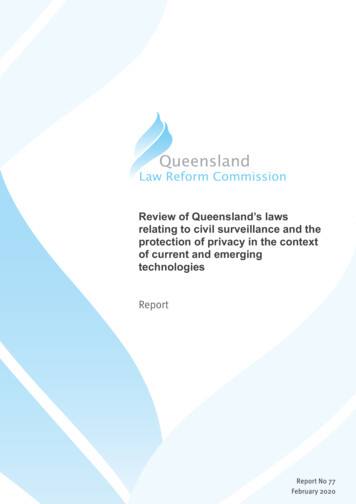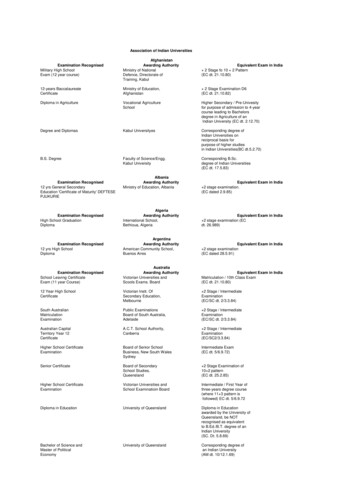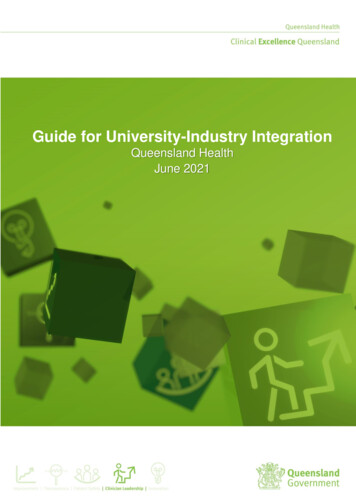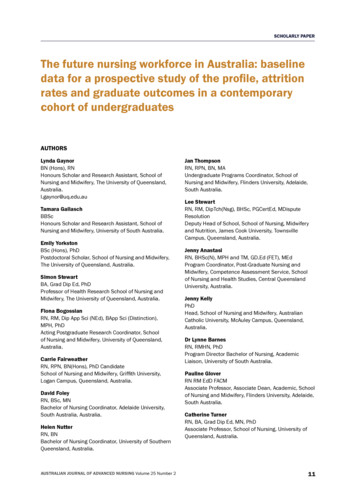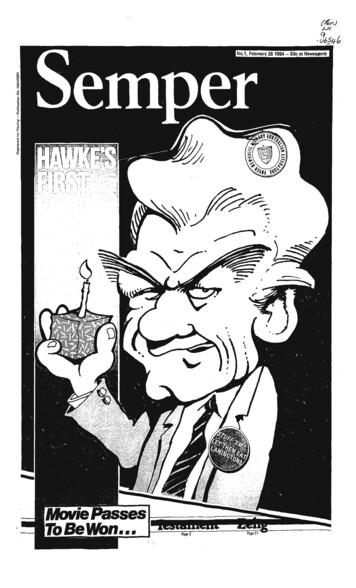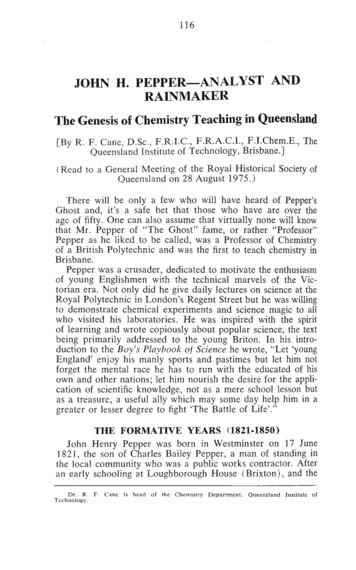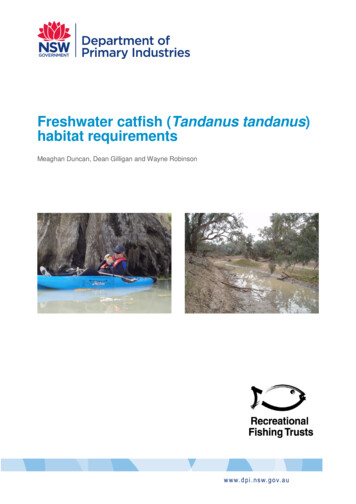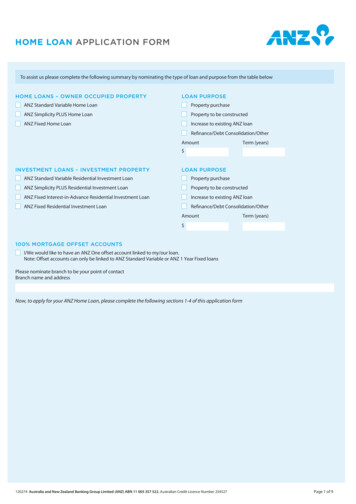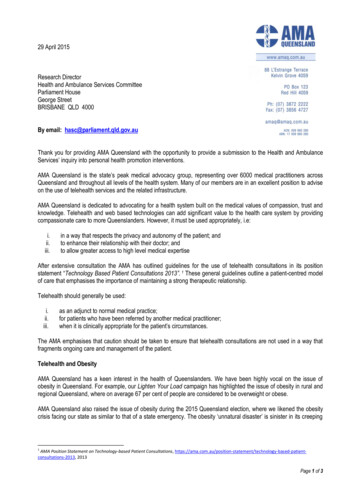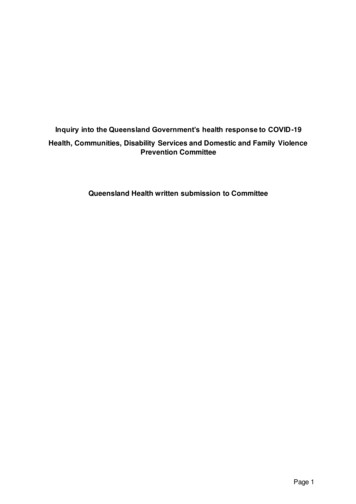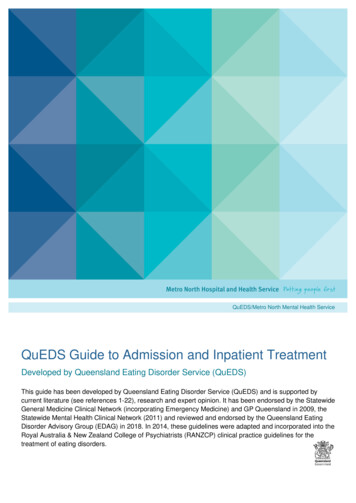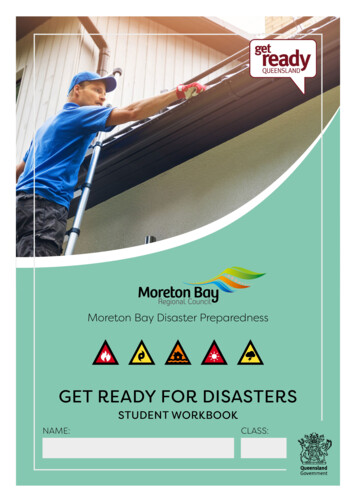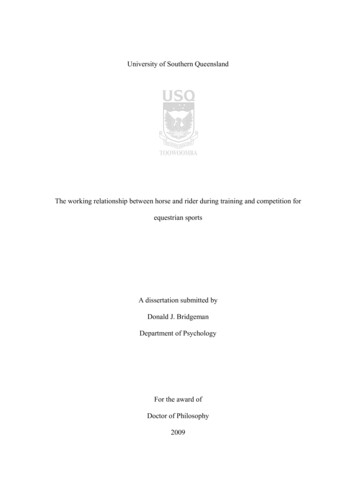
Transcription
University of Southern QueenslandThe working relationship between horse and rider during training and competition forequestrian sportsA dissertation submitted byDonald J. BridgemanDepartment of PsychologyFor the award ofDoctor of Philosophy2009
iCertification of DissertationI certify that the ideas, experimental work, results, analyses and conclusionsreported in this dissertation are entirely my own effort, except where otherwiseacknowledged. I also certify that the work is original and has not been previouslysubmitted for any other award, except where otherwise acknowledged.Signature of CandidateDateEndorsementSignature of supervisorDate
iiThe HorseWhere in this wide world can man find nobility without pride,Friendship without envy, or beauty without vanity.Here, where grace is served with muscle and strength by gentleness confinedHe serves without servility; he has fought without enmity.There is nothing so powerful, nothing less violent.There is nothing so quick, nothing more patient.Our past has been borne on his back.All our history is in his industry.We are his heirs, he our inheritance.Duncun (1954)
iiiPublicationsBridgeman, D. J., & Pretty, G. M. (2005). Exploring heart rate as an indicator ofsynchronisation between dressage horse and rider at training and competition.Paper presented at the ISSP 11th World Congress of Sport Psychology,Sydney, Australia.Pretty, G. M., & Bridgeman, D. J. (2005). Of two minds: Consulting with the horseand-rider team in dressage, showjumping and polo. In J. Dosil (Ed.), The SportPsychologist's Handbook (pp. 569 - 585). Chichester, West Sussex: JohnWiley.Bridgeman, D. J., Pretty, G. M. & Tribe. A. (2006). Heart rate synchronisation ofdressage horse and rider during the warm up period for a competitiondressage test. Paper presented at the Australian Equine Science Symposium,Surfers Paradise, Australia.
ivAbstractThe working relationship between horses and riders is a unique associationrequiring cooperation between both to achieve the goals of humans in their selectedequestrian sport. This dissertation chose the equestrian sports of eventing and dressageto investigate this working relationship between horse and rider, and its stability acrosstraining and competition settings. Consideration was given to psychological,physiological and behavioural factors for the human and horse. The research requiredthe development of a measure to indicate the harmony of the working relationship,which resulted in a rider and observer inventory, and of a physiological indicator of therelationship which became the correlation between the horse and rider heart rate andwas called heart rate synchronisation. To examine reactive behavioural factors of thehorse a horse Behaviour Check List was created, and to consider possible psychologicalfactors implicated in this behaviour a Horse Temperament Inventory was developed.Anxiety was the psychological factor chosen to assess the rider, and the CompetitiveState Anxiety Inventory – 2 and the Emotion and Mood Components of Anxiety –Questionnaire were used as its different components.It was hypothesized that there would be significant environmental differencesbetween most factors with the competition environment showing evidence of lowerworking relationship scores, higher heart rates, higher rider anxiety, and more reactivehorse behaviours. Horse temperament was considered to be a trait and therefore nodifferences were predicted. Negative relationships were hypothesized between theworking relationship measures and rider anxiety components, horse temperament andcritical horse behaviours. A positive relationship was hypothesized between rider selfconfidence and the working relationship. Negative relationships were also predictedbetween rider anxiety, horse temperament and horse behaviour. No specific predictions
vwere made regarding relationships between rider and horse heart rates and the otherfactors.In Study 1 with five eventing teams, results from Cohen’s d analyses ofdifferences between means supported some hypotheses. A moderate to large effect sizewas found for rider’s somatic anxiety and heart rate being higher in the competitionenvironment, but no significant effects were found for the rider’s cognitive anxiety andlevels of self-confidence across environments. However, contrary to hypotheses,working relationship and the heart rate synchronisation factors had higher scores in thecompetition environment and showed a small and large effect size respectively. Thehorse’s temperament was also more positive in the competition environment, with theHorse Temperament Inventory – Rider (HTI-R) revealing a small effect size and theHorse Temperament Inventory – Observer (HTI-O) without the rider a large effect size,suggesting that it seems to be identifying a psychological state of the horse rather thanthe hypothesized temperament traits. The hypothesis regarding the horse and rider’sheart rate was also accepted as they also increased in the competition environment. Thehorse’s maximum heart rate and minimum heart rate showed a moderate effect size anda large effect size was found in the differences of the horse’s mean heart rate. Therider’s maximum heart rate and mean heart rate data also showed a large effect size andthe rider’s minimum heart rate means showed a moderate effect size. Due to unforeseencircumstances and the low number of participants, the hypotheses could not beevaluated using inferential statistics. However, the patterns of the findings led to somemodifications of methods and the selection of another equestrian sport for Study 2.The findings from Study 2 with thirty dressage teams indicate the workingrelationship between horse and rider was stable across environments during a dressagetest. The heart rate synchronisation analysis was able to identify significant
virelationships between most horse and rider teams during a dressage test in both thetraining and competition environments. At a group level the correlation between thehorse and rider heart rates displayed a significant positive relationship in the trainingenvironment, but not in the competition environment. A t-test analysis found stabilityof the horse’s temperament across environments, suggesting that the HorseTemperament Inventory is measuring temperament traits. Also the rider’s somaticanxiety showed a significant increase in the competition environment, which was alsoreflected in the rider’s emotional experience of this anxiety. Unexpectedly the rider’sself-confidence was also significantly higher in the competition environment. However,no predicted associations were found between working relationship scores and heartrate synchronisation, or between these measures and horse and rider factors.The relationship between reactive horse misbehaviours and rider anxiety, andthe team’s working relationship was analysed. A significant association was foundbetween each of the rider’s and judge’s ratings of the working relationship and heartrate synchronisation with the horse’s misbehaviour scores in the competitionenvironment. The rider’s somatic anxiety also showed a significant association with thehorse’s misbehaviour in both the training and competition environments. Significantrelationships were also found between horse misbehaviour and performance in bothtraining and competition environments. To extend this investigation further adiscriminant function analysis was conducted to determine if the riders with levels ofhigh and low cognitive and somatic anxiety could be categorised on the basis of horsetemperament. It revealed that riders with high and low levels of somatic anxiety couldbe categorised on the basis of the horse’s temperament score, whereas riders with highand low levels of cognitive anxiety could be classified on the basis of the horse’s heartrate means in the competition environment.
viiOverall, the dissertation has significant methodological, conceptual andpractical outcomes. It demonstrates possible self report, observational and physiologicalindicators to assess the horse-rider working relationship, and a reliable measure ofhorse temperament. It also addresses several speculations, assumptions and anecdotalreferences in the literature about the interactive association between horse and rider.Findings here point to significant associations between horse and rider psychology andphysiology, and patterns of relationships that may indicate some relevance to theworking relationship, and ultimately performance.
viiiContentsCertification of Dissertation . iThe Horse . iiPublications . iiiAbstract . ivContents. viiiList of tables . xivList of figures . xviiPreface . xviiiAcknowledgements . xxIntroduction . 1The rationale and overview of the dissertation . 1Dissertation Objectives . 4Dissertation organisation . 5Chapter 1.Exploring horse and rider factors and interactions, and implications forthe equestrian team’s working relationship: A literature review . 71.1 A brief history of horse-human relationships. 71.2 Factors implicit in the equestrian working relationship . 91.3 Temperament of the equine team member (Equus caballus) . 161.3.1 Methodological issues in assessing horse temperament . 201.4 Anxiety of the human team member . 281.4.1 Anxiety in sport . 291.4.2 State anxiety in equestrian sport . 321.4.3 Distinctions between the emotion and mood experience of anxiety. 391.5 Heart rates in the equestrian team . 44
ix1.5.1 Horse heart rate . 461.5.2 Rider heart rate. 491.6 Developing a measure of the equestrian working relationship . 521.7 Summary . 54Chapter 2.The working relationship between horse and rider during the cross-country phase of eventing . 56Abstract . 562.1 Introduction . 572.2.1 Objectives and hypotheses . 612.3 Methods . 622.3.1 Participants and research sites . 622.3.2 Measures . 642.3.3 Procedure . 742.4 Results . 772.4.1 Data preparation and analysis procedures. 772.4.2 Analysis of the measures . 782.4.3 The environmental impact on the horse-rider relationship . 792.4.4 Psychological and physiological assessment of the rider . 792.4.5 Psychological and physiological assessment of the horse . 812.5 Discussion . 842.5.1 Environmental influences on the working relationship between horse andrider . 852.5.2 Environmental influences on the individual horse-rider factors considered tobe implicated in the relationship. . 872.5.3 Methodological considerations . 91
x2.5.4 Preview of the next study. 96Chapter 3.The working relationship between the dressage horse and rider duringtraining and competition . 98Abstract . 983.1 Introduction . 993.1.1 Hypotheses . 1043.2 Methods . 1053.2.1 Participants and Research Sites . 1053.2.2 Measures . 1063.2.3 Procedure . 1113.3 Results . 1143.3.1 Preparation and descriptive analysis of data . 1143.3.2 Riders’ perception of competition . 1173.3.3 The working relationship between horse and rider . 1183.3.4 The rider psychological factors. 1223.3.5 Rider heart rate. 1253.3.6 The relationship between the rider’s cognitive and somatic anxiety and heartrate . 1263.3.7 Assessment of the horse in the training and competition environments. 1273.3.8 Relationships between horse and rider psychological factors, and workingrelationship indicators . 1273.3.9 Post hoc consideration of the CSAI-2 subscales comparing dressage andshowjumping riders at competition. 1293.4 Discussion . 129
xi3.4.1 The working relationship and heart rate synchronisation between horse andrider . 1303.4.2 Horse and rider factors related to the working relationship. 1323.4.3 Stability of the working relationship and individual factors. 1333.4.4 Methodological considerations . 1383.5 Summary and Conclusions . 142Chapter 4.A closer look at horse behaviour and its relationship to rider anxiety andtheir working relationship . 144Abstract . 1444.1 Introduction . 1454.1.1 Hypotheses . 1484.2 Method . 1494.2.1 Participants and research sites . 1494.2.2 Measures . 1494.2.3 Procedures . 1504.3 Results . 1514.3.1 Environmental impact on horse behaviour . 1514.3.2 Horse behaviour and temperament, and rider anxiety and association with theworking relationship and heart rate synchronisation . 1514.3.3 A discriminant analysis of riders with high and low anxiety on the basis ofhorse characteristics . 1544.4 Discussion and Conclusion . 158Chapter 5.General discussion and conclusion . 1635.1 The working relationship between horse and rider . 1635.2 Horse and rider factors and their association with the working relationship . 166
xii5.3 Methodological considerations and limitations . 1735.4 Future research directions . 1755.5 Conclusion. 177References . 178Appendix A . 201Eventing research training questionnaire . 201Appendix B . 207Eventing research competition questionnaire . 207Appendix C . 214Eventing research training questionnaire . 214Appendix D . 221Eventing research competition questionnaire . 221Appendix E. 228Animal ethics approval letter . 228Appendix F . 229Human ethics approval letter . 229Appendix G . 230Consent form to participate in the eventing research . 230Appendix H . 232Extra tables for for Study 1 . 232Appendix I . 238Dressage research Training Questionnaire . 238Appendix J . 244Dressage research competition questionnaire . 244Appendix K . 251
xiiiConsent form to participate in the Dressage Research . 251Appendix L. 253Letter of approval from Dressage Queensland to use heart rate monitors . 253Appendix M . 255Extra Tables for study 2 . 255
xivList of tablesTable 1.1: Summary of research into horses’ temperament and/or specific dimensionspresented in chronological order . 21Table 2.1: The demographic information and competition data summary of riders andhorses . 63Table 2.2: The WRI-R scores and HRS means, σ standard deviations and Cohen’s d . 79Table 2.3: Means, σ standard deviations, and effect sizes, for the rider CSAI-2, CSAI2R, EMCA-Q, and heart rate. . 81Table 2.4: Means, standard deviations, and effect size across training and competitionenvironments for horse temperament and heart rate scores. . 82Table 2.5: A comparison of the horse behaviours without rider in training andcompetition . 83Table 2.6: A comparison of the horse behaviours with the rider in training andcompetition . 84Table 3.1: Descriptive statistics of participants’ characteristics . 106Table 3.2: Summary of the Cronbach alpha statistics for the psychological measures forthe rider, the horse, and the working relationship rating measures . 108Table 3.3: Means and standard deviations of all variables. . 116Table 3.4: Pearson correlation coefficients indicating the heart rate synchronisationofeach horse and rider team during dressage tests in training and competitionenvironments . 121Table 3.5: The Pearson correlation coefficients for the WRI-R, WRI-J and the HRS inthe training (T) and competition (C) environments . 122Table 3.6: MANOVA results of the rider CASI-2 subscales scores in the training andcompetition environments. . 123
xvTable 3.7: Means and standard deviations and MANOVA results of CSAI-2R subscales. 124Table 3.8: Means and standard deviations and MANOVA results of EMCA-Qsubscales . 125Table 3.9: The t statistics for rider heart rates during the dressage tests . 125Table 3.10: Pearson coefficients between the riders’ cognitive and somatic anxiety,their heart rate mean and their heart rate entering the arena at A during a dressage testin the training and competition environments . 126Table 3.11: Shows the Pearson correlation coefficients between rider anxiety variablesand heart rate synchronisation in the training (T) and competition environments (C). 128Table 4.1: The Pearson coefficients of horse misbehaviour and tail position with thehorse, working relationship and performance variables at training . 152Table 4.2: The Pearson coefficients of horse misbehaviour and tail position with thehorse, working relationship and performance variables at competition . 153Table 4.3: Summary of the regression analysis predicting rider competition somaticanxiety . 154Table 4.4: Means and standard deviations of variables for rider’s somatic anxietygroups and the tests of equality of means for a discriminant analysis . 155Table 4.5: The results of discriminant function analysis of somatic anxiety of riders 156Table 4.6 Means and standard deviations of variables for riders’ cognitive anxietygroups and the tests of equality of means for a discriminant analysis . 157Table 4.7 The results of discriminant function analysis of riders with low and highcognitive anxiety . 158Table A.1: The working relationship scores and heart rate synchronisation values foreach eventing team . 232
xviTable A.2: Anxiety and heart rate variables for riders. 233Table A4: Behaviours of horses . 235Table A.5: The skewness and kurtosis for all dependent variables . 255Table A.6: A Pearson correlation of the synchronicity of Heart rate for horse and riderfor each 5 second interval during the dressage. . 256
xviiList of figuresFigure 2.1: Polar S610 coded receiver . 71Figure 2.2: Polar T61 coded transmitter . 71Figure 2.3 Polar T52H coded heart rate transmitter . 74
xviiiPrefaceA life amongst horses drives a desire to comprehend how we have thisextraordinary working relationship with nature’s most noble creature.Horsemanship skills have been passed traditionally by word of mouth fromone horse trainer to the next. Thus, a lot of knowledge and skill has been lost with thepassing of these horsemen as little documentation exists of their expertise. Indeed,much of the literature that does exist regarding the working relationship between horseand rider is derived from a few anecdotal sources. These originate from historicalaccounts which also reflect superstition and cultural traditions of horsemen from aroundthe world. These horsemen used many different training strategies and techniqueswhich are based on as many varied philosophies. The horse-rider partnership isconsidered to be very emotive, and conjecture regarding this working relationship isthat it is within the domain of a sacred attachment (Keaveney, 2008).To a person who regularly trains horses this absence of evidence-basedunderstanding of the equine-human working relationship is frustrating. Equestrian sportdemands horse and rider work together to succeed. Thus, the evaluation andunderstanding of both horse and rider behaviour as it occurs interactively is required todetermine factors that promote good teamwork and performance during competition.To consider both horse and rider factors in the one study requires theresearcher to cross the bo
indicators to assess the horse-rider working relationship, and a reliable measure of horse temperament. It also addresses several speculations, assumptions and anecdotal references in the literature about the interactive association between horse and rider. Findings here point to significant associations between horse and rider psychology and
